New perk: Easily find new routes and hidden gems, upcoming running events, and more near you. Your weekly Local Running Newsletter has everything you need to lace up! Subscribe today.
If you’re a runner, getting injured isn’t a matter of if—it’s a matter of when. We know that’s not what you want to hear, but the data on common running injuries doesn’t lie. Research shows that 65 percent of runners will experience some sort of running-related injury. A 2021 study showed that the ankles (35 percent), knees (28 percent), and lower legs (13 percent) are the most vulnerable areas.
With this in mind, we turned to the experts on running injuries—Nicole Haas, DPT, an orthopedic clinical specialist, and Jamie Mieras, MD, a sports medicine podiatrist at Boulder Valley Foot and Ankle Clinic—to explain how to manage these issues when they strike.
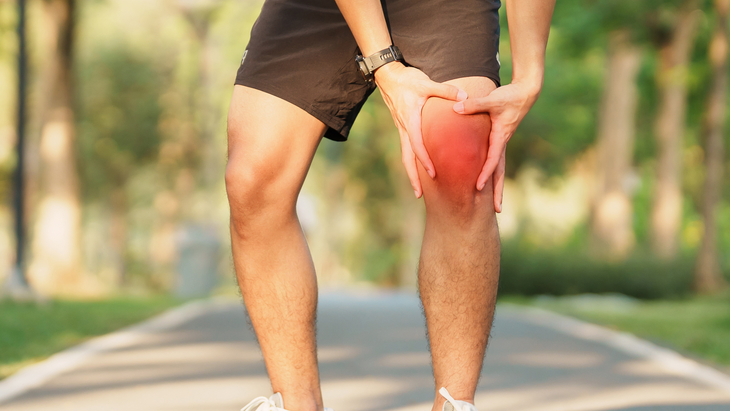
#1: Runner’s Knee
Patellofemoral pain syndrome is so common among runners—accounting for 16.3 percent of all running injuries—that it’s been bestowed with the moniker “runner’s knee.” It’s a condition that causes discomfort around or behind the kneecap. It typically develops gradually and is often linked to increased activity levels, especially high-impact movements like running, squatting, or climbing stairs.
RELATED: Everything You Need to Know About Runner’s Knee
Symptoms of Runner’s Knee
- Pain around or behind the kneecap
- Knee stiffness
- Clicking or popping sensations
- A creaking or grinding feeling in the knee
Treating Runner’s Knee
Your first move is to reduce the inflammation with NSAIDs, rest, and ice. It’s okay to run on it as long as it doesn’t hurt, but skip the long runs and focus on rebuilding your form. Often, patellofemoral pain syndrome develops when you aren’t strong enough to keep yourself in proper biomechanical alignment. This puts undue stress on the patellar (kneecap), causing inflammation and irritation. “Focusing on glute strengthening and leg alignment (preventing the knee from collapsing inward) while strengthening the quads is crucial,” says Haas.
Weak hip abductors and feet can also contribute to runner’s knee, so focus on building strength in these oft-neglected areas.
RELATED: Are Weak Hips Limiting Your Running? Take These Tests to Find Out.

#2: IT Band Syndrome
Your iliotibial (IT) band runs along the outside of your hip down to your knee. When this thick tendon becomes inflamed, it causes pain on the outside of the knee that is especially noticeable when running downhill. “Weak hips, which can cause runners to have a knock-kneed gait, cause friction and irritation,” says Haas. Too much volume can also cause the IT band to be abnormally tight and pull at the point of attachment, causing pain. Surveys suggest that 12 to 14 percent of runners experienced IT band pain in the past year.
RELATED: How to Treat IT Band Syndrome
Symptoms of IT Band Syndrome
- Pain along the outer thigh, typically between the hip and knee
- Discomfort that worsens with activity, especially running
- Tightness and aching on the lateral (outer) side of the knee
- Swelling around the outside of the knee, often seen in long-distance runners
- Pain that may be misdiagnosed as general lateral knee pain
Treating IT Band Syndrome
One common short-term treatment is a corticosteroid injection. If the pain is caused by decreased mobility of the IT band, foam rolling, massage, and stretching will help loosen the tissue. Because biomechanics also play a role, strengthen your hip abductors to help prevent the pain.
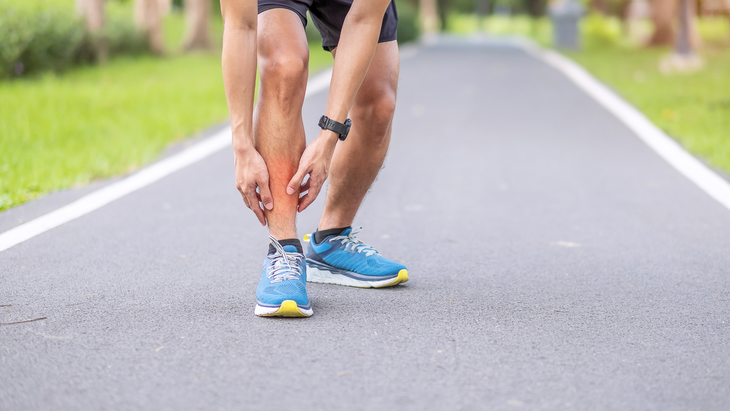
#3: Shin Splints (Tibial Stress Injury)
Shin splints are a vague and diffused pain on the front of the shin. The condition is usually caused by “too much, too fast” training, which doesn’t allow enough time for the tibia and surrounding musculature to properly heal between runs. The front of the tibia can be tender and inflamed, and this pain may decrease a few miles into your run. If left untreated for too long, shin splints can turn into a full-blown stress fracture. Women have a higher propensity for low bone density than men, increasing their odds of shin splints turning into a stress fracture 1.5 to 3 times.
Symptoms of Shin Splints
- Pain along the inner edge of the shinbone (tibia)
- Tenderness and/or soreness in the lower leg
- Pain that worsens with activity
- A dull, aching sensation that can become sharp with continued exercise
Treating Shin Splints
First of all: think about your shoes. Shin splints are often caused by newer runners logging miles in cross trainers or old running shoes with poor support. If this sounds like you, go to your local running store and invest in a good pair of shoes as a first step. Next, rest, NSAIDs, and ice can help reduce acute pain and inflammation. If the pain persists, you might need to take a look at your running form. The underlying issues are typically training errors or biomechanical abnormalities that place more strain on the tibia and tibialis than they can handle.
“Classically, we see people with very stiff ankle joints, and that pulls on the muscle,” Haas says. “That stiffness can result in compensatory movements and muscle use that can lead to aggravation of those muscles and eventually their attachment on the tibia.” Work on mobilizing the ankle by stretching the calf muscles and working with a physical therapist on mobilization movements. Primary strength work should focus on the tibialis posterior, ankle-stabilization muscles, and calf muscles, with secondary work on the core and hips.
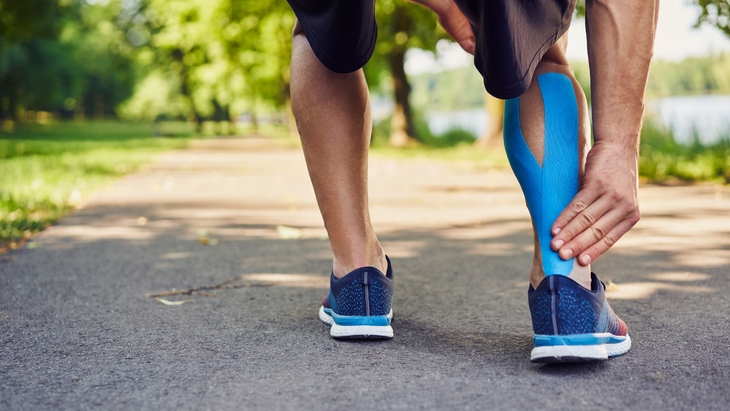
#4: Achilles Tendinitis
This continuous pain on the back of the lower leg occurs when the Achilles tendon, which connects your calf muscles to your heel, becomes inflamed and irritated. Achilles tendinitis is often the result of an increase in mileage, intensity, or hill workouts.
Symptoms of Achilles Tendinitis
- Pain and stiffness along the Achilles tendon, especially in the morning
- Pain that worsens with activity
- Tenderness when touching, pressing, or pinching the tendon
- Swelling in the tendon
- Difficulty pushing off the foot or standing on tiptoes
Treating Achilles Tendinitis
Like most overuse injuries, Achilles Tendinitis requires a period of rest. (We know, not what you want to hear.) But avoiding hilly runs, overstriding, and lessening mileage can go a long way in reducing pain. Fortunately, the Achilles tendon is one of the strongest in the body and can recover quickly.
RELATED: How to Beat Achilles Tendinitis
Once the acute pain is under control, work on strengthening the calf muscles, which is the key to long-term treatment. Calf stretches performed with special emphasis on the eccentric phase—where the muscle is contracted as it lengthens—are widely regarded as the panacea.
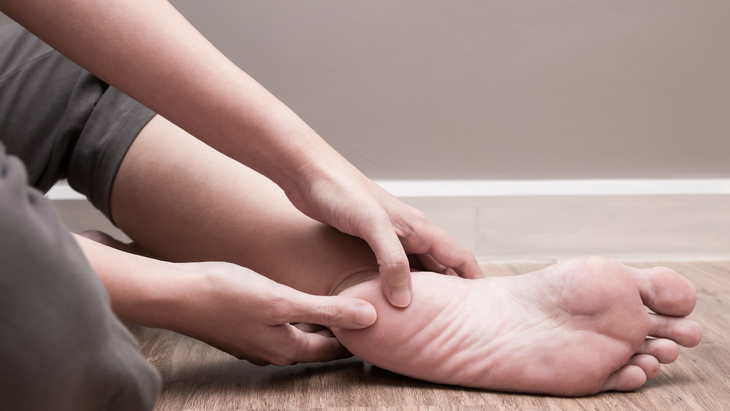
#5: Plantar Fasciitis
Pronounced “PLAN-ter fash-ee-EYE-tus,” this is a painful inflammation of the thick tissue that runs along the bottom of the foot. The pain is typically a dull ache adjacent to the heel (calcaneus), but it can be sharp first thing in the morning. “Plantar fasciitis results from overuse on mildly ‘off’ biomechanics, which is usually exacerbated by weak feet,” says Mieras. Because the tissue receives limited blood flow, this injury tends to linger.
Symptoms of Plantar Fasciitis
- Sharp or stabbing pain in the bottom of the foot, usually near the heel
- Pain that is worst in the morning or after long periods of rest
- Discomfort that eases with movement (like after one mile) but may return after prolonged activity (like after mile 10)
- Tenderness along the arch of the foot
Treating Plantar Fasciitis
Since this is an overuse inflammatory condition, ice it when it flairs. NSAIDs can also provide temporary relief.
RELATED: I Tried Everything to Treat Plantar Fasciitis—Here’s What Worked
Upstream from the foot, tight calf muscles are thought to be a major cause, so consistently stretching them is key. If you’re having heel pain first thing in the morning (a hallmark sign of the condition), sleeping in a night splint can help keep the fascia elongated when it would normally overtighten. And reconsider your footwear. “Your biomechanics may benefit from more supportive shoes or adding rigid over-the-counter inserts to support the arch until the inflammation resolves,” says Mieras.
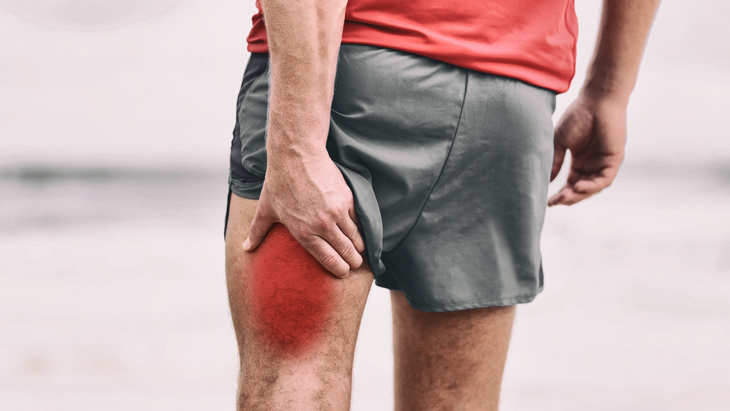
#6: Hamstring Strain
Three muscles on the back of your thigh are tasked with bending your knee, and the hamstrings are the tendons that attach these big, thick muscles to the bone. Injuries to the hamstrings are usually located at the attachment or involve tears or strains to the tendon. Although more common in athletes who sprint, endurance athletes can injure their hamstrings through chronic overuse or muscle imbalances.
Symptoms of Hamstring Strain
- Pain in the back of the thigh of butt
- Bruising or inflammation along the back of the thigh
- Tightness in the hamstrings
- A sudden sharp pain or popping sensation in the back of the thigh could indicate a tear
Treating Hamstring Strain
A tight hamstring is susceptible to being overstretched and strained. Make sure the posterior muscles (located on your backside) and tendons have the required range of motion and appropriate mobility. If you can’t touch your knees, let alone your toes, we’re talking to you.
Related: 3 Exercises to Strengthen Hamstrings
“Eccentric strengthening of the hamstring has been shown to help recover from a strain and will be beneficial regardless of where the pain is in the hamstring,” says Haas. Long-distance runners with weak glutes might overcompensate with their hamstrings. Activating and strengthening your glutes and hips will reduce hamstring demand and irritation.
#7: Stress Fractures
One of the more serious common running injuries, “[A stress fracture] is that nagging pain that people don’t want to admit to themselves,” says Meiras. The pain is caused by tiny cracks in the bone. Presenting in runners most often in the shins (tibias), feet (metatarsals), or heels (calcaneus), stress fractures are caused by an overload of repetitive stress—the impact of the ground from running.
Symptoms of a Stress Fracture
- Gradual onset of pain that worsens with activity and improves with rest
- Tenderness at a specific spot over the bone
- Swelling around the affected area
- Dull or aching pain that may become sharp with continued stress
- Pain that intensifies with weight-bearing activities like running or jumping
- Possible bruising in severe cases
Treating Stress Fractures
If you suspect you’re dealing with a stress fracture, head to the doctor and get an X-ray. (Some stress fractures are so small they won’t appear on X-rays and might require an MRI.) To heal properly, rest is a non-negotiable and you can expect eight to 16 weeks of fun with crutches. Your doctor will prescribe physical therapy, which will help in the remodeling of the bone.
Once it’s healed, research shows that weight-bearing exercises, like strength training, have a bone-strengthening effect. Enough stress helps your bones grow stronger, so plyometrics and even running will lessen your likelihood of suffering a future stress fracture—as long as you don’t overdo it. Long-term, Haas says, “Work with someone to analyze your biomechanics,” because poor form can increase ground-reaction forces and put more stress on your bones.

#8: Ankle Sprain
An ankle sprain is an acute injury caused by a twisting or rolling movement that tears the ligaments surrounding the ankle. Whether it happens on the trail or after dropping off a curb, sprains are extremely painful and cause the ankle to become inflamed immediately. This isn’t just a roll, and you’ll be able to tell the difference thanks to the pain and swelling level. It’s one of the most common running injuries, especially among trail runners.
Symptoms of Ankle Sprains
- Pain, especially when bearing weight on the affected ankle
- Swelling around the ankle joint (it can be mild or get huge)
- Bruising or discoloration in the injured area
- Tenderness to touch
- Instability or weakness in the ankle
- Limited range of motion
- A popping sensation at the time of injury
Treating Ankle Sprains
While a mild sprain doesn’t necessarily need medical intervention, seeking professional advice is always your best bet. (Sometimes what looks like a sprain is actually a break and vice versa.) So step one is heading to your local urgent care or sports doctor.
“Ankle sprains will tell you how you should treat them,” Mieras says. “If it hurts, don’t run on it.” The classic RICE treatment works well with this injury: Resting it allows it to heal. Icing causes the blood vessels to constrict and prevents further leakage of blood and serum into the area. Compressing, or wrapping the ankle with an Ace bandage, manually pushes out the inflammation. Elevation allows gravity to help remove some of the swelling.
Once you are past the acute phase (usually two weeks), research suggests strengthening the surrounding musculature and balance training to improve ankle stability and avoid a repeat.
RELATED: 5-Stage Rehab Program Following an Ankle Sprain
Don’t rush back into running either—the ligaments will be tender and need time to heal. The best way to come back stronger is to work with a physical therapist to strengthen the lower leg and feet.